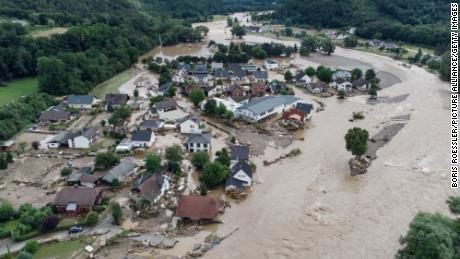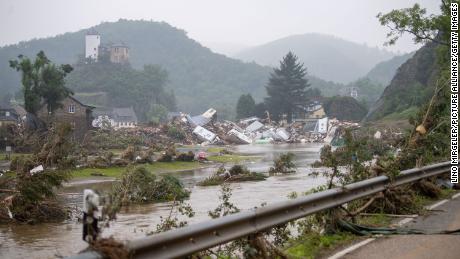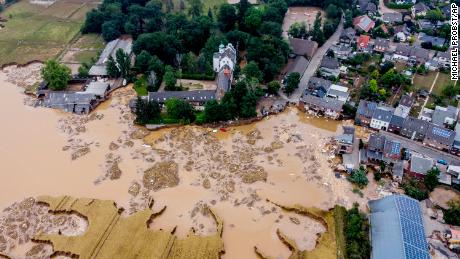Desperate search for survivors as western Europe reels from a ‘catastrophe of historic proportion’
At least 133 people died in Germany when the floods swept across the western states of North-Rhine Westphalia, Rhineland-Palatine and Saarland. In Belgium, 24 were confirmed dead, with authorities warning the number could go up.
Luxembourg and the Netherlands have also been affected by the extreme rainfall, but have not reported any fatalities.
Images showed entire towns and villages underwater, cars wedged between collapsed buildings and homes buried under landslides and debris.
Residents described the chaos that ensued when the water rose, making it impossible to escape the area and trapping people in their homes.
“The water was so high that you couldn’t go with smaller cars, they had special cars, and went in and tried to get [as] many people as possible out of that area. The whole night helicopters were coming and even tried to pull out people there,” Michael Kautsch told CNN.
Kautsch lives in Erftstadt, a town near Cologne that has become one of the symbols of the destruction. A number of buildings, including parts of a historical castle, were destroyed after a large sinkhole opened in a nearby quarry. “The water was flowing and pulled parts of the town into that hole, and now … the fire department says that there could be so much water under the buildings that a lot of buildings still can be damaged and can crash together,” Kautsch said.
Communication lines remain disrupted across the flooded areas, leaving people unable to reach loved ones.
Police in Koblenz told CNN on Saturday that while up to 1,300 people were still unaccounted for, authorities were hoping the numbers would be revised down as the rescue operation continues.
“There is no end in sight just yet,” Ulrich Sopart, a police spokesman in the city, told CNN. ”Our hopes are that some people might have been registered as missing twice or even three times — if for example a family member, a work colleague or a friend has registered a person as missing,” Sopart said.
”Also, [in] some places phone lines are still down and reception is difficult. We do hope that people will get in touch with a relative, work colleague or friend to let them know they are fine,” he said.
The German army deployed 850 soldiers for disaster relief and the German President Frank-Walter Steinmeier is scheduled to visit the Rhein-Erft district of North Rhine-Westphalia state on Saturday, his office said.
Villages along the river Ahr have been left without power and phone coverage, with some areas completely cut off, forcing the military and search and rescue helicopters to survey the area from the air, searching for stranded survivors.
A dam along the river Rur in North Rhine-Westphalia broke Friday night, according to the regional government. Officials have started the evacuation of about 700 residents in the Ophoven neighborhood in the city of Wassenberg.
Across the border in Belgium, the Belgian army is racing against the time with search and rescue operations.
Marie-Louise Grosjean, a shop owner in Pepinster, Belgium, saw a decade of hard work swept away by water and mud on Friday, when the water entered her wine and decorations store. She said her father has lived in the town for 70 years and has never seen anything like that. Grosjean’s son Arthur told CNN the flooding game very quickly, leaving only destruction behind.
“Thankfully I don’t live there but it’s my mother’s business and there is nothing here. We hope we can quickly repair but we don’t know how,” he said, as he was helping the clear-up.
“The situation is changing by the minute, and remains extremely critical in many places,” Prime Minister Alexander De Croo said at a news conference on Friday. “The victims are the priority, rescuing is the priority, and care. All possible means are mobilized,” he added, announcing that Belgium will hold a national day of mourning for flood victims on Tuesday.
Meanwhile in the Netherlands, Dutch officials ordered the evacuation of 10,000 people in the municipality of Venlo, where the Maas river rose faster than expected. The high waters are expected to last until Sunday evening.
Officials fear more dams could break and are closely monitoring reservoirs in the region. On Friday, a hospital in the region with 200 patients was evacuated.
Climate crisis fueling extreme rainfall
The devastating floods came after large swaths of western Europe experienced historic levels of rainfall, with more than a month’s worth of rain falling within 24 hours.
Cologne, in North Rhine-Westphalia, recorded 154 millimeters (6 inches) of rainfall in the 24 hours to Thursday morning, which is nearly double its monthly average for July of 87 millimeters. In the Ahrweiler district, 207 millimeters (8.1 inches) of rain fell in only nine hours, according to the European Severe Weather Database.
The downpours resulted in extreme flash flooding, with water levels rising within minutes.
The premier of North Rhine-Westphalia in Germany, Armin Laschet, who is also the Conservatives’ candidate to succeed Chancellor Angela Merkel in the upcoming federal election, said the floods in his state were “a catastrophe of historic proportion,” calling on the world to speed up its efforts to both mitigate and adapt to climate change.
“The floods have literally pulled the rug from under people’s feet,” Laschet said.
“We will be faced with such events over and over, and that means we need to speed up climate protection measures, on European, federal and global levels, because climate change isn’t confined to one state,” he said.
While the overall amount of rainfall may not change over the course of the year in any given location, more of the rain is expected to fall in shorter bursts, which would tend to increase the frequency of flooding events.
This was noted by scientists with the European Environmental Agency, who said that “the projected increase in frequency and intensity of heavy precipitation over large parts of Europe may increase the probability of flash floods, which pose the highest risk of fatality.”
Droughts, which are also becoming more common because of the climate crisis, can make flash flooding worse because very dry soil cannot efficiently absorb water.
A 2016 flooding in Western Europe that killed 18 in Germany, France, Romania and Belgium, was analyzed by scientist to see if climate change played a role in the floods. They found that a warmer climate made the flooding 80-90% more likely to occur than it was in the past before man-made climate change.
CNN’s Sam Kiley, Barbara Wojazer, Melissa Bell, Chris Burns, Joseph Ataman, Nadine Schmidt, Schams Elwazer, Sharon Braithwaite, Vasco Cotovio, Angela Dewan, Ulrike Dehmel and Brandon Miller contributed reporting.
![]()








